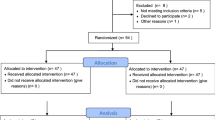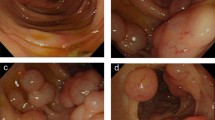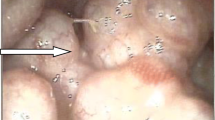Abstract
Purpose
We report a case in which pigmented peritoneal deposits were found during laparoscopic surgery following preoperative endoscopic tattooing for sigmoid colon cancer.
Methods
The patient’s clinical, endoscopic, and histological data from the Niigata City General Hospital were reviewed, as well as the literature on laparoscopic surgery involving the preoperative endoscopic tattoo, with a focus on the relevance of peritoneal deposits and tattooing ink.
Results
A 71-year-old man presented to our hospital complaining of vomiting and abdominal distention. Abdominal computed tomography revealed obstructive sigmoid colon cancer. An emergency endoscopic colon stenting procedure and injection of 0.2 ml India ink to the submucosal layer of the tumor’s anal side were performed. Laparoscopic-assisted sigmoid colectomy was done 14 days after stenting. At surgery, seven small peritoneal deposits were seen in the rectovesical pouch and at the site adjacent to the tumor. All peritoneal deposits were stained by the ink. Gross leakage of the ink into extraintestinal sites was seen. The seven peritoneal deposits were resected under laparoscope. Histological findings revealed that the seven peritoneal deposits were composed of adenocarcinoma and carbon pigments. Immunohistochemical staining for cluster of differentiation 163 showed that the carbon pigments in the peritoneal deposits were within macrophages.
Conclusions
The possibility of the tattooing procedure causing peritoneal dissemination cannot be completely denied, but it can be hypothesized that the carbon pigmentation was transferred to peritoneal deposits by macrophages. In the future, we hope that this phenomenon becomes a keystone for diagnoses and treatments for peritoneal dissemination.




Similar content being viewed by others
References
Askin MP, Waye JD, Fiedler L, Harpaz N (2002) Tattoo of colonic neoplasms in 113 patients with a new sterile carbon compound. Gastrointest Endosc 56:339–342
Park JW, Sohn DK, Hong CW, Han KS, Choi DH, Chang HJ, Lim SB, Choi HS, Jeong SY (2008) The usefulness of preoperative colonoscopic tattooing using a saline test injection method with prepackaged sterile India ink for localization in laparoscopic colorectal surgery. Surg Endosc 22:501–505. https://doi.org/10.1007/s00464-007-9495-2
Sawaki A, Nakamura T, Suzuki T, Hara K, Kato T, Kato T, Hirai T, Kanemitsu Y, Okubo K, Tanaka K, Moriyama I, Kawai H, Katsurahara M, Matsumoto K, Yamao K (2003) A two-step method for marking polypectomy sites in the colon and rectum. Gastrointest Endosc 57:735–737. https://doi.org/10.1067/mge.2003.174
Tutticci N, Cameron D, Croese J, Roche E (2010) Peritoneal deposits with carbon pigmentation associated with endoscopic submucosal tattooing of a rectal cancer. Endoscopy 42:E136. https://doi.org/10.1055/s-0029-1244049
Lau SK, Chu PG, Weiss LM (2004) CD163: a specific marker of macrophages in paraffin-embedded tissue samples. Am J Clin Pathol 122:794–801. https://doi.org/10.1309/QHD6YFN81KQXUUH6
Cappell MS, Courtney JT, Amin M (2010) Black macular patches on parietal peritoneum and other extraintestinal sites from intraperitoneal spillage and spread of India ink from preoperative endoscopic tattooing: an endoscopic, surgical, gross pathologic, and microscopic study. Dig Dis Sci 55:2599–2605. https://doi.org/10.1007/s10620-009-1044-5
Komohara Y, Fujiwara Y, Ohnishi K, Takeya M (2016) Tumor-associated macrophages: potential therapeutic targets for anti-cancer therapy. Adv Drug Deliv Rev 99:180–185. https://doi.org/10.1016/j.addr.2015.11.009
Ostuni R, Kratochvill F, Murray PJ, Natoli G (2015) Macrophages and cancer: from mechanisms to therapeutic implications. Trends Immunol 36:229–239. https://doi.org/10.1016/j.it.2015.02.004
Allavena P, Sica A, Solinas G, Porta C, Mantovani A (2008) The inflammatory micro-environment in tumor progression: the role of tumor-associated macrophages. Crit Rev Oncol Hematol 66:1–9. https://doi.org/10.1016/j.critrevonc.2007.07.004
Author information
Authors and Affiliations
Contributions
H Uehara reviewed the medical record and scientific literature and wrote the manuscript. T Yamazaki supervised and reviewed critically the manuscript. H Hashidate interpreted the histological specimens and reviewed critically the manuscript. I Shioi proofread and reviewed critically the manuscript. All other authors reviewed critically the manuscript. All authors approved the final version of the manuscript.
Corresponding author
Ethics declarations
Conflict of interest
The authors declare that they have no conflict of interest.
Institutional review board statement
The publication of this case report was approved by the ethics committee of Niigata City General Hospital.
Informed consent statement
The patient’s written consent was obtained for publication of this case report.
Rights and permissions
About this article
Cite this article
Uehara, H., Yamazaki, T., Iwaya, A. et al. A rare case of peritoneal deposits with carbon pigmentation after preoperative endoscopic tattooing for sigmoid colon cancer. Int J Colorectal Dis 34, 355–358 (2019). https://doi.org/10.1007/s00384-018-3189-1
Accepted:
Published:
Issue Date:
DOI: https://doi.org/10.1007/s00384-018-3189-1




